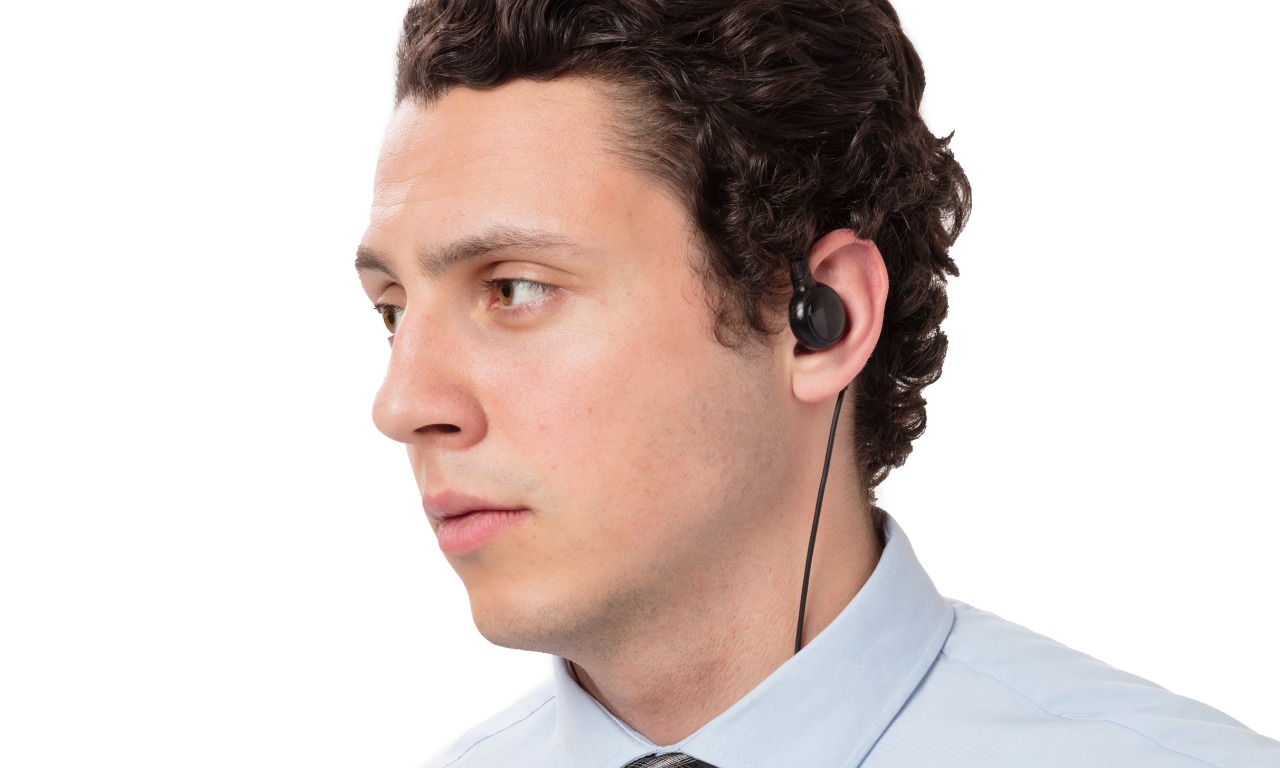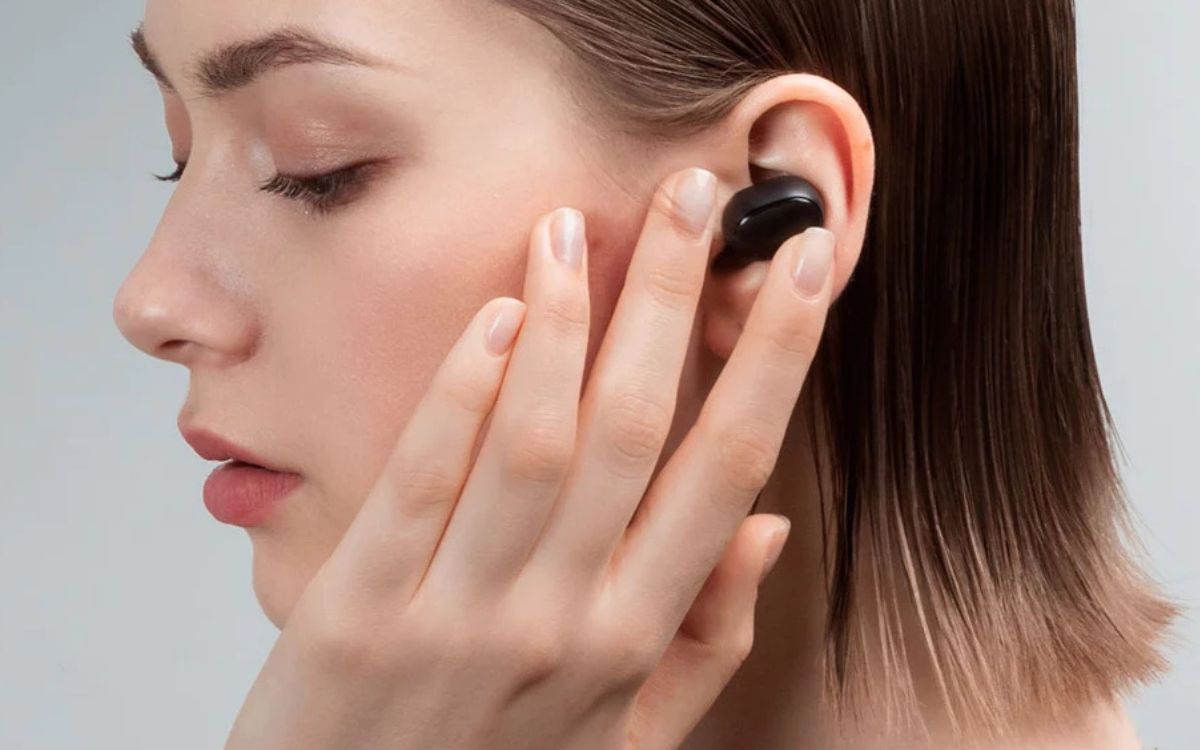Home>Devices & Equipment>Radio>How To Wear Radio Earpiece


Radio
How To Wear Radio Earpiece
Published: November 10, 2023
Learn how to properly wear a radio earpiece for clear communication on the go. Enhance your radio experience with our step-by-step guide.
(Many of the links in this article redirect to a specific reviewed product. Your purchase of these products through affiliate links helps to generate commission for AudioLover.com, at no extra cost. Learn more)
Table of Contents
- Introduction
- Understanding Radio Earpieces
- Choosing the Right Radio Earpiece
- Adjusting the Earpiece for Comfort
- Placing the Earpiece Correctly
- Securing the Earpiece in Place
- Connecting the Earpiece to the Radio
- Testing the Earpiece for Proper Functioning
- Maintaining and Cleaning the Earpiece
- Troubleshooting Common Issues
- Conclusion
Introduction
Welcome to the world of radio communication! Whether you’re a radio enthusiast, working in the security or event management industry, or simply an avid radio listener, you’ve probably come across the term “radio earpiece” at some point. Radio earpieces, also known as radio headsets or radio headphones, are devices that allow users to listen to audio transmissions from a radio receiver directly into their ears. They provide a hands-free and discreet communication solution, making them an essential accessory in various professions where clear and private communication is crucial.
In this article, we will explore the world of radio earpieces and provide you with a comprehensive guide on how to wear them correctly. From understanding the different types of radio earpieces to troubleshooting common issues, we’ve got you covered.
Before we dive into the how-to’s, let’s take a moment to understand why using a radio earpiece can be beneficial. Whether you’re working in security, law enforcement, hospitality, or any other field that requires instant communication, having a reliable and efficient communication system is essential. Radio earpieces allow for hands-free communication, enabling you to keep your hands free for other tasks while staying connected. They also provide privacy, ensuring that sensitive information is only heard by authorized personnel. Moreover, radio earpieces deliver clear audio directly into your ears, even in noisy environments, improving the overall communication experience and reducing misunderstandings.
Now that we’ve established the importance and benefits of radio earpieces, let’s delve into the various aspects of wearing them correctly. From choosing the right earpiece to adjusting it for comfort and ensuring proper connectivity, we will guide you step by step through the process. So, let’s get started on our journey to becoming radio earpiece experts!
Understanding Radio Earpieces
Before we dive into the details of how to wear a radio earpiece, it’s important to understand the different types and components of these devices. Radio earpieces come in various styles and designs, each catering to specific needs and preferences. Let’s explore some of the key aspects of radio earpieces:
1. Types of Radio Earpieces: There are two main types of radio earpieces: in-ear and over-the-ear. In-ear earpieces, also known as earbuds, fit snugly inside the ear canal and provide a discreet and comfortable wearing experience. Over-the-ear earpieces, on the other hand, have a band that goes over the ear and a speaker that rests against the ear, providing a more secure fit for active situations.
2. Components of a Radio Earpiece: A typical radio earpiece consists of several components, including the earpiece itself, a microphone, and a connection cable. The earpiece is designed to deliver audio directly into the ear, while the microphone allows for two-way communication, enabling you to speak into the device. The connection cable connects the earpiece to the radio receiver, ensuring seamless communication.
3. Compatibility: It’s important to ensure that the radio earpiece you choose is compatible with your specific radio model. Different radios may have different connector types, so be sure to check the compatibility before making a purchase. Some earpieces come with universal connectors that can be adapted to fit various radio models.
4. Noise Cancellation: Many radio earpieces are equipped with noise-canceling features, which help to block out background noise and improve audio clarity. This is particularly beneficial in loud and noisy environments, ensuring that you can hear incoming transmissions loud and clear.
By understanding these key aspects of radio earpieces, you can make an informed decision when purchasing and wearing one. In the next sections, we will guide you on how to choose the right radio earpiece, adjust it for comfort, and ensure proper connectivity, so that you can make the most out of your communication device. Let’s move on to the next section: “Choosing the Right Radio Earpiece.”
Choosing the Right Radio Earpiece
When it comes to choosing a radio earpiece, there are a few factors to consider to ensure that you select the right one for your needs. Here are some essential considerations to keep in mind:
1. Compatibility: Ensure that the earpiece you choose is compatible with your specific radio model. Different radios may have different connector types, so it’s crucial to check the compatibility before making a purchase. Look for earpieces that offer universal connectors or those specifically designed for your radio make and model.
2. Style and Design: Radio earpieces come in various styles and designs, including in-ear, over-the-ear, and covert options. The choice of style depends on your personal preference, comfort, and usage requirements. In-ear earpieces are discreet and comfortable, while over-the-ear models provide a secure fit for active situations. Covert earpieces are designed to be discreet and blend in with clothing or accessories for undercover operations.
3. Comfort: Since you’ll be wearing the radio earpiece for extended periods, comfort is crucial. Look for earpieces with soft and ergonomic designs that fit securely without causing discomfort. Adjustable ear hooks or cushions can provide a customized fit for your ears.
4. Durability: Radio earpieces are often used in demanding environments, so it’s important to choose a durable and reliable option. Look for earpieces made from high-quality materials that can withstand daily wear and tear, including moisture and impact resistance.
5. Noise Cancellation: If you work in noisy environments or need clear communication, consider choosing an earpiece with noise cancellation features. Noise-canceling earpieces help to block out background noise, ensuring that incoming transmissions are heard clearly.
6. Budget: Set a budget for your radio earpiece purchase. Prices can vary depending on the brand, features, and quality. Consider your requirements and prioritize the features that are most important to you.
Taking these factors into account will help you narrow down your options and select a radio earpiece that meets your needs and preferences. Once you have chosen the right earpiece, the next step is to adjust it for optimal comfort. In the next section, we will guide you on how to adjust and wear your radio earpiece properly. So, let’s move on to “Adjusting the Earpiece for Comfort.”
Adjusting the Earpiece for Comfort
Once you have chosen the right radio earpiece, it’s important to adjust it properly for maximum comfort. A well-adjusted earpiece ensures a secure fit and minimizes discomfort during extended use. Follow these steps to adjust your radio earpiece:
1. Earpiece Position: Start by positioning the earpiece in a comfortable position. For in-ear earpieces, gently insert the earbuds into your ear canal until they fit snugly. Be careful not to push them too far, as this can cause discomfort. For over-the-ear earpieces, place the speaker against your ear, ensuring it rests comfortably and securely while allowing clear audio transmission.
2. Earpiece Angle: Adjust the angle of the earpiece to ensure optimal audio reception and comfort. For in-ear earpieces, angle the earbuds slightly towards the front of your face for better audio projection. For over-the-ear earpieces, adjust the position of the speaker to align with your ear canal for clear sound transmission.
3. Ear Hook or Cushion Adjustment: If your earpiece has adjustable ear hooks or cushions, customize their position to fit your ears comfortably. Gently adjust the hooks or cushions to match the contours of your ears, ensuring a secure and snug fit without causing discomfort or pressure points.
4. Cable Management: Ensure that the connection cable is properly managed to prevent tangling or pulling on the earpiece. Adjust the length of the cable to allow freedom of movement without any strain or tension. You can use cable clips or cable management accessories to keep the cable neatly organized and out of the way.
5. Test Comfort and Fit: Once you have adjusted the earpiece, test its comfort and fit by moving your head and performing different movements that you would typically do during your activities. Ensure that the earpiece stays securely in place and doesn’t cause any discomfort or shifting. If necessary, readjust the earpiece until you find the most comfortable and secure fit.
By taking the time to adjust your radio earpiece properly, you can ensure a comfortable and secure fit throughout your use. A well-fitted earpiece enhances the overall communication experience and minimizes fatigue and distraction. In the next section, we will discuss the correct placement of the earpiece to optimize audio reception and transmission. So, let’s proceed to “Placing the Earpiece Correctly.”
Placing the Earpiece Correctly
Placing the radio earpiece correctly is essential for optimal audio reception and transmission. The position of the earpiece ensures that you can hear incoming transmissions clearly and that your voice is picked up by the microphone effectively. Follow these steps to place your earpiece correctly:
1. In-Ear Earpiece: For in-ear earpieces, gently insert the earbuds into your ear canal until they fit snugly. Ensure that the earpiece is positioned securely and comfortably in your ear. The earbuds should create a seal in your ear canal to minimize background noise and enhance the audio clarity.
2. Over-the-Ear Earpiece: For over-the-ear earpieces, position the speaker against your outer ear. The speaker should align with your ear canal for clear audio transmission. Ensure that the earpiece fits securely and doesn’t move or slide during use. Adjust the angle of the speaker if needed to optimize audio reception.
3. Mic Placement: If your earpiece includes a microphone, ensure that it is positioned correctly. The microphone should be placed close to your mouth, but not obstructing it. Position it at a comfortable distance from your lips, typically around 1-2 inches away. This allows for clear and effective voice transmission without any distortion or muffling.
4. Secure Fit: After placing the earpiece and adjusting the microphone, ensure that everything is securely in place. Gently tug on the connection cable to check for any looseness or movement. If necessary, make further adjustments to ensure a secure and stable fit, as any movement or shifting can affect the audio quality and overall user experience.
5. Check Comfort: Finally, take a moment to assess the comfort of the placed earpiece. Ensure that it feels comfortable and doesn’t cause any pain or discomfort, especially during long-wearing periods. Remember, a well-placed and comfortable earpiece allows for uninterrupted and clear communication.
By placing the radio earpiece correctly, you can optimize the audio reception and transmission, ensuring clear communication. In the next section, we will discuss how to secure the earpiece in place to prevent any accidental dislodgement. So, let’s move on to “Securing the Earpiece in Place.”
Securing the Earpiece in Place
Securing the radio earpiece in place is essential to prevent any accidental dislodgment during your activities. Once you have positioned the earpiece correctly, follow these steps to ensure it stays securely in place:
1. In-Ear Earpiece: For in-ear earpieces, gently rotate the earbuds slightly in a clockwise or counterclockwise direction to create a tight seal in your ear canal. This helps to anchor the earpiece and prevents it from slipping out. If necessary, you can also use optional ear hooks or cushions that come with the earpiece to provide additional stability and support.
2. Over-the-Ear Earpiece: For over-the-ear earpieces, make sure that the band or loop that goes over your ear is properly adjusted. It should fit comfortably and securely around the back of your ear, providing stability and preventing the earpiece from moving or falling off during physical activity. Some over-the-ear models may also have clips or attachments that you can use to secure the earpiece to your clothing or accessories.
3. Use Adjustable Straps: Certain earpieces come with adjustable straps or clips that can be used to secure the connection cable to your clothing or equipment. This prevents the cable from dangling or getting caught on objects, reducing the risk of accidentally pulling the earpiece out. Adjust the strap or clip according to your needs, making sure it is snug but not too tight.
4. Test for Stability: Once you have secured the earpiece in place, perform some movements or activities that you typically engage in while wearing the earpiece. This could include walking, running, bending, or any other physical movements. Check for any movement or discomfort in the earpiece. If you feel it shifting or becoming loose, readjust the position or straps to ensure a secure fit.
5. Regularly Check: During prolonged use, regularly check the stability and position of the earpiece. If you feel any discomfort or notice any loosening, take a moment to readjust and secure it as necessary. Regular checks and adjustments will help maintain optimal audio reception and prevent any distractions or interruptions during communication.
By following these steps to secure your radio earpiece, you can have peace of mind knowing that it will stay in place, even during active movements. With the earpiece securely fixed, you can focus on your tasks and communicate effectively. Next, we will discuss how to connect the earpiece to the radio for seamless communication. Let’s move on to “Connecting the Earpiece to the Radio.”
Connecting the Earpiece to the Radio
Once you have adjusted and secured your radio earpiece, the next step is to connect it to your radio device. Properly connecting the earpiece ensures a seamless and reliable communication experience. Follow these steps to connect the earpiece to the radio:
1. Identify the Connection Port: Locate the connection port on your radio device. It is usually located on the side or front of the radio and labeled as “earphone” or “audio” jack. Make sure to check the user manual or consult the manufacturer’s guidelines if you are having trouble locating the port.
2. Insert the Connector: Take the connector end of the earpiece cable and carefully insert it into the connection port of the radio. Ensure that it is inserted fully and securely to establish a proper connection. You may feel a slight click or resistance when it is fully inserted.
3. Secure the Connection: Once the connector is inserted into the port, give it a gentle tug to ensure it is securely connected. A loose or weak connection can result in intermittent audio or signal interference. If you find any issues, remove the connector and reinsert it, ensuring a strong and secure connection.
4. Cable Management: After connecting the earpiece to the radio, manage the excess cable to prevent tangling or obstruction during use. Route the cable in a way that allows for easy movement and doesn’t interfere with your activities. You can use clips or cable management accessories to secure the cable to your clothing or equipment.
5. Test the Communication: Once the earpiece is connected, turn on your radio and test the communication. Ensure that you can hear incoming transmissions clearly through the earpiece and that your voice is transmitted effectively through the microphone. Adjust the volume settings if needed to achieve optimal audio levels.
It’s important to note that different radio models may have varying connection types, such as 3.5mm, 2.5mm, or proprietary connectors. Ensure that the earpiece you have chosen is compatible with your specific radio’s connector type. If necessary, you may need to purchase an adapter to connect the earpiece to your radio device.
By following these steps to connect the earpiece to your radio device, you can establish a reliable and clear communication link. With the earpiece properly connected, you are ready to communicate effectively and efficiently. In the next section, we will discuss how to test the earpiece for proper functioning. Let’s move on to “Testing the Earpiece for Proper Functioning.”
Testing the Earpiece for Proper Functioning
After connecting your radio earpiece to the device, it’s important to test its functionality to ensure that it is working properly. This step is crucial to verify that you can receive and transmit audio effectively. Follow these steps to test the earpiece for proper functioning:
1. Audio Reception: To test the earpiece’s audio reception, have someone transmit a test message or tune in to a radio channel. Listen carefully through the earpiece to ensure that you can hear the incoming transmissions clearly. Adjust the volume if needed to achieve a comfortable and audible level.
2. Audio Transmission: To test the earpiece’s audio transmission, speak into the microphone while monitoring the radio device. Confirm that your voice is being transmitted effectively and clearly to the other users or listeners. Ask for feedback from others to ensure that your voice is coming through accurately.
3. Signal Clarity: Pay attention to the clarity of the received audio. Ensure that there is no static, interference, or distortion that may impact the communication experience. If you encounter any noise or poor signal quality, check the connection and adjust the earpiece position or volume settings accordingly.
4. Range Test: If possible, perform a range test to determine the effective communication distance between your radio device and the earpiece. Walk or move around while maintaining communication and observe if there are any dropouts or loss of signal. This test can help you assess the range limitations of the earpiece and make necessary adjustments if needed.
5. Test in Different Environments: Test the earpiece in various environments where you are likely to use it, such as outdoors, indoors, or in noisy environments. Evaluate the performance of the earpiece under different conditions to ensure that it meets your communication needs across different scenarios.
If you encounter any issues during the testing phase, refer to the troubleshooting section of the earpiece’s user manual or contact the manufacturer for assistance. It’s important to address any problems promptly to ensure a seamless communication experience.
By thoroughly testing the earpiece for proper functioning, you can have confidence in its performance and rely on it for clear and effective communication. In the next section, we will discuss how to maintain and clean your radio earpiece to keep it in optimal condition. Let’s move on to “Maintaining and Cleaning the Earpiece.”
Maintaining and Cleaning the Earpiece
Maintaining and cleaning your radio earpiece is essential to prolong its lifespan and ensure optimal performance. Regular maintenance helps prevent the accumulation of dirt, debris, and moisture that can affect the audio quality and overall function. Follow these guidelines to properly maintain and clean your earpiece:
1. Handle with Care: Treat your earpiece with care to avoid accidental damage. Avoid dropping, twisting, or bending the earpiece, as these actions can impact its functionality. When not in use, store the earpiece in a protective case or pouch to prevent any physical damage.
2. Regular Inspections: Periodically inspect the earpiece for any signs of wear, loose connections, or frayed cables. If you notice any issues, address them promptly. Regular inspections help identify potential problems early on and prevent them from escalating.
3. Cleaning: Clean the earpiece regularly to remove dirt, debris, and earwax buildup that can accumulate over time. Use a soft cloth or a cotton swab slightly dampened with water or a mild cleaning solution to gently wipe the external surfaces of the earpiece, including the earbuds, speaker, and microphone. Avoid using harsh chemicals or abrasive materials that can damage the earpiece.
4. Ear Tips or Cushions: For in-ear earpieces, if they have detachable ear tips or cushions, remove them and clean them separately. Wash them with mild soap and water, rinse thoroughly, and air dry before reattaching them to the earpiece. This helps maintain hygiene and prolongs the life of the ear tips or cushions.
5. Cable Care: Take care of the connection cable by avoiding excessive bending, pulling, and twisting. If the cable becomes tangled, gently untangle it to prevent any strain or damage. Regularly check the cable for any signs of wear or fraying. If you notice any issues, consider replacing the cable to maintain optimal performance.
6. Storage: When not in use, store the earpiece in a clean and dry environment. Avoid exposing it to extreme temperatures, humidity, or direct sunlight, as these can damage the electronic components. Use the provided storage case or pouch to protect the earpiece from dust, moisture, and other potential hazards.
7. Follow Manufacturer’s Guidelines: Always follow the manufacturer’s guidelines and recommendations regarding maintenance and cleaning. Some earpieces may have specific instructions or cleaning solutions that are recommended for the best results. It’s important to adhere to these guidelines to ensure the longevity and performance of your earpiece.
By regularly maintaining and cleaning your radio earpiece, you can extend its lifespan and optimize its performance. Proper maintenance ensures that you can rely on your earpiece for clear and effective communication. In the next section, we will address some common issues that you may encounter with radio earpieces and provide troubleshooting tips. Let’s proceed to “Troubleshooting Common Issues.”
Troubleshooting Common Issues
While radio earpieces are reliable communication tools, there may be times when you encounter common issues that can affect their performance. Here are some troubleshooting tips to help you address these issues:
1. No Audio: If you’re not able to hear any audio through your earpiece, first ensure that it is properly connected to the radio device. Check the volume settings on both the radio and the earpiece. If the issue persists, try connecting a different pair of earphones or speakers to the radio to determine if it is a problem with the earpiece or the radio itself.
2. Poor Audio Quality: If the audio quality is distorted, muffled, or faint, check the earpiece’s positioning. Ensure that it is snugly inserted in the ear canal or securely placed against the ear. Adjust the volume settings on both the radio and the earpiece to find a suitable level. If the issue persists, try cleaning the earpiece and conducting a range test to ensure that interference or signal loss is not the cause.
3. Loose Connection: If you notice a loose connection between the earpiece and the radio device, check if the connector is securely inserted into the audio jack. Ensure that there are no obstructions or debris in the port that may prevent a proper connection. If the issue persists, try using a different connector cable or adapter to see if the problem lies with the cable itself.
4. Earpiece Dislodgment: If the earpiece keeps falling out of your ear or shifting during use, adjust the earpiece position, ear hooks, or cushions to achieve a more secure fit. Consider using optional clips or straps to fasten the cable to your clothing or equipment to prevent accidental dislodgment.
5. Microphone Issues: If others are not able to hear you clearly, check if the microphone is correctly positioned and not obstructed. Ensure that it is at an appropriate distance from your mouth for optimal sound transmission. Make sure that the microphone’s sensitivity or volume settings on the radio are properly configured.
6. Battery Life: If your earpiece is powered by batteries and you notice a short battery life, check if the batteries are fully charged or replace them if necessary. Follow the manufacturer’s recommendations for battery usage and charging times. If the issue persists, there may be a problem with the earpiece’s power management system, and you should reach out to the manufacturer for assistance.
If you are unable to resolve the issue after troubleshooting, consult the user manual or contact the manufacturer’s customer support for further guidance. They will be able to provide specific troubleshooting steps or recommend professional assistance, if needed.
By troubleshooting common issues with your radio earpiece, you can quickly identify and resolve any problems that may arise, ensuring smooth and uninterrupted communication. Now that you have a comprehensive understanding of radio earpieces and how to address common issues, you are well-equipped to make the most out of your communication device. Let’s conclude our guide on wearing radio earpieces in the next section.
Conclusion
Congratulations! You have now reached the end of our comprehensive guide on wearing radio earpieces. We have covered important aspects such as understanding radio earpieces, choosing the right one for your needs, adjusting it for comfort, placing it correctly, securing it in place, connecting it to your radio device, testing for proper functioning, maintaining and cleaning it, and troubleshooting common issues. Armed with this knowledge, you are well-prepared to confidently and effectively use your radio earpiece for clear and seamless communication.
Remember, choosing the right earpiece that fits comfortably and suits your specific needs is key to maximizing your communication experience. Take the time to adjust and position the earpiece correctly, ensuring a secure fit and optimal audio reception. Properly connecting the earpiece to your radio device is essential, as is regularly testing for audio transmission and reception. Maintaining and cleaning your earpiece will keep it in optimal condition and prolong its lifespan.
If you encounter any issues along the way, don’t worry. Use the troubleshooting tips we provided to address common problems or consult the manufacturer’s guidelines for more specific guidance. With a little practice and familiarity, wearing a radio earpiece will become second nature to you.
Now, go out there and enjoy the benefits of your radio earpiece. Whether you’re using it for work, events, or personal communication, you can rely on it for clear and private communication, keeping you connected and enhancing your overall productivity. Stay informed, stay connected, and make the most out of your radio earpiece!











